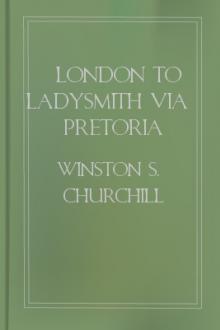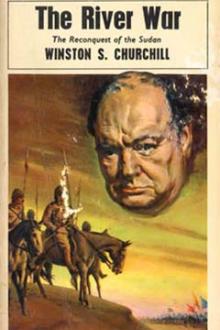London to Ladysmith via Pretoria - Winston Churchill (some good books to read TXT) 📗

- Author: Winston Churchill
- Performer: -
Book online «London to Ladysmith via Pretoria - Winston Churchill (some good books to read TXT) 📗». Author Winston Churchill
General Hildyard, with whom was Prince Christian Victor, spent the night in improving the defences of the hill and in building new traverses and head cover. At midnight the Boers made a fresh effort to regain the position, and the sudden roar of musketry awakened the sleeping army. The attack, however, was easily repulsed. At daybreak the shelling began again, only now the Boers had brought up several new guns, and the bombardment was much heavier. Owing, however, to the excellent cover which had been arranged the casualties during the day did not exceed forty. The Cavalry and Transport, who were sheltering in the hollows underneath Zwartkop, were also shelled, and it was thought desirable to move them back to a safer position.
In the evening Sir Redvers Buller, who throughout these two days had been sitting under a tree in a somewhat exposed position, and who had bivouacked with the troops, consulted with his generals. Many plans were suggested, but there was a general consensus of opinion that it was impossible to advance further along this line. At eleven at night Hildyard's Brigade was withdrawn from Vaal Krantz, evacuating the position in good order, and carrying with them their wounded, whom till dark it had been impossible to collect. Orders were issued for the general retirement of the army to Springfield and Spearman's, and by ten o'clock on the 8th this operation was in full progress.
With feelings of bitter disappointment at not having been permitted to fight the matter out, the Infantry, only two brigades of which had been sharply engaged, marched by various routes to their former camping grounds, and only their perfect discipline enabled them to control their grief and anger. The Cavalry and Artillery followed in due course, and thus the fourth attempt to relieve Ladysmith, which had been begun with such hopes and enthusiasm, fizzled out into failure. It must not, however, be imagined that the enemy conducted his defence without proportionate loss.
What I have written is a plain record of facts, and I am so deeply conscious of their significance that I shall attempt some explanation.
The Boer covering army numbers at least 12,000 men, with perhaps a dozen excellent guns. They hold along the line of the Tugela what is practically a continuous position of vast strength. Their superior mobility, and the fact that they occupy the chord, while we must move along the arc of the circle, enables them to forefront us with nearly their whole force wherever an attack is aimed, however it may be disguised. Therefore there is no way of avoiding a direct assault. Now, according to Continental experience the attacking force should outnumber the defence by three to one. Therefore Sir Redvers Buller should have 36,000 men. Instead of this he has only 22,000. Moreover, behind the first row of positions, which practically runs along the edge of an unbroken line of steep flat-topped hills, there is a second row standing back from the edge at no great distance. Any attack on this second row the Artillery cannot support, because from the plain below they are too far off to find the Boer guns, and from the edge they are too close to the enemy's riflemen. The ground is too broken, in the opinion of many generals, for night operations. Therefore the attacking Infantry of insufficient strength must face unaided the fire of cool, entrenched riflemen, armed with magazine weapons and using smokeless powder.
Nevertheless, so excellent is the quality of the Infantry that if the whole force were launched in attack it is not impossible that they would carry everything before them. But after this first victory it will be necessary to push on and attack the Boers investing Ladysmith. The line of communications must be kept open behind the relieving army or it will be itself in the most terrible danger. Already the Boers' position beyond Potgieter's laps around us on three sides. What if we should break through, only to have the door shut behind us? At least two brigades would have to be left to hold the line of communications. The rest, weakened by several fierce and bloody engagements, would not be strong enough to effect the relief.
The idea of setting all on the turn of the battle is very grateful and pleasant to the mind of the army, which only asks for a decisive trial of strength, but Sir Redvers Buller has to remember that his army, besides being the Ladysmith Relief Column, is also the only force which can be spared to protect South Natal. Is he, therefore, justified in running the greatest risks? On the other hand, how can we let Ladysmith and all its gallant defenders fall into the hands of the enemy? It is agonising to contemplate such a conclusion to all the efforts and sacrifices that have been made. I believe and trust we shall try again. As long as there is fighting one does not reflect on this horrible situation. I have tried to explain some of the difficulties which confront the General. I am not now concerned with the attempts that have been made to overcome them. A great deal is incomprehensible, but it may be safely said that if Sir Redvers Buller cannot relieve Ladysmith with his present force we do not know of any other officer in the British Service who would be likely to succeed.
CHAPTER XXIHUSSAR HILL
Map of the Operations of the Natal Field Army from January 11 to February 9
General Buller's Headquarters: February 15, 1900.
When Sir Redvers Buller broke off the combat of Vaal Krantz, and for the third time ordered his unbeaten troops to retreat, it was clearly understood that another attempt to penetrate the Boer lines was to be made without delay.
The army has moved from Spearman's and Springfield to Chieveley, General Lyttelton, who had succeeded Sir Francis Clery, in command of the 2nd Division and 4th Brigade, marching via Pretorius's Farm on the 9th and 10th, Sir Charles Warren covering the withdrawal of the supplies and transport and following on the 10th and 11th. The regular Cavalry Brigade, under Burn-Murdoch, was left with two battalions to hold the bridge at Springfield, beyond which place the Boers, who had crossed the Tugela in some strength at Potgieter's, were reported to be showing considerable activity. The left flank of the marching Infantry columns was covered by Dundonald's Brigade of Light Horse, and the operations were performed without interruption from the enemy. On the 12th orders were issued to reconnoitre Hussar Hill, a grassy and wooded eminence four miles to the east of Chieveley, and the direction of the next attack was revealed. The reader of the accounts of this war is probably familiar with the Colenso position and understands its great strength. The proper left of this position rests on the rocky, scrub-covered hill of Hlangwani, which rises on the British side of the Tugela. If this hill can be captured and artillery placed on it, and if it can be secured from cross fire, then all the trenches of Fort Wylie and along the river bank will be completely enfiladed, and the Colenso position will become untenable, so that Hlangwani is the key of the Colenso position. In order, however, to guard this key carefully the Boers have extended their left—as at Trichardt's Drift they extended their right—until it occupies a very lofty range of mountains four or five miles to the east of Hlangwani, and along all this front works have been constructed on a judicious system of defence. The long delays have given ample time to the enemy to complete his fortifications, and the trenches here are more like forts than field works, being provided with overhead cover against shells and carefully made loopholes. In front of them stretches a bare slope, on either side rise formidable hills from which long-range guns can make a continual cross-fire. Behind this position, again, are others of great strength.
But there are also encouraging considerations. We are to make—at least in spite of disappointments we hope and believe we are to make—a supreme effort to relieve Ladysmith. At the same time we are the army for the defence of South Natal. If we had put the matter to the test at Potgieter's and failed, our line of communications might have been cut behind us, and the whole army, weakened by the inevitable heavy losses of attacking these great positions, might have been captured or dispersed. Here we have the railway behind us. We are not as we were at Potgieter's 'formed to a flank.' We derive an accession of strength from the fact that the troops holding Railhead are now available for the general action.
Besides these inducements this road is the shortest way. Buller, therefore, has elected to lose his men and risk defeat—without which risk no victory can be won—-on this line. Whether he will succeed or not were foolish to prophesy, but it is the common belief that this line offers as good a chance as any other and that at last the army will be given a fair run, and permitted to begin a general engagement and fight it out to the end. If Buller goes in and wins he will have accomplished a wonderful feat of arms, and will gain the lasting honour and gratitude of his country. If he is beaten he will deserve the respect and sympathy of all true soldiers as a man who has tried to the best of his ability to perform a task for which his resources were inadequate. I hasten to return to the chronicle. Hussar Hill—so-called because a small post of the 13th Hussars was surprised on it six weeks ago and lost two men killed—is the high ground opposite Hlangwani and the mountainous ridges called Monte Cristo and Cingolo, on which the Artillery must be posted to prepare the attack. Hence the reconnaissance of the 12th.
At eight o'clock—we never get up early in this war—Lord Dundonald started from the cavalry camp near Stuart's Farm with the South African Light Horse, the Composite Regiment, Thorneycroft's Mounted Infantry, the Colt Battery, one battalion of Infantry, the Royal Welsh Fusiliers, and a battery of Field Artillery. The Irregular Horse were familiar with the ground, and we soon occupied Hussar Hill, driving back a small Boer patrol which was watching it, and wounding two of the enemy. A strong picket line was thrown out all round the captured ground and a dropping musketry fire began at long range with the Boers, who lay hidden in the surrounding dongas. At noon Sir Redvers Buller arrived, and made a prolonged reconnaissance of the ground with his telescope. At one o'clock we were ordered to withdraw, and the difficult task of extricating the advanced pickets from close contact with the enemy was performed under a sharp fire, fortunately without the loss of a man.
After you leave Hussar Hill on the way back to Chieveley camp it is necessary to cross a wide dip of ground. We had withdrawn several miles in careful rearguard fashion, the guns and the battalion had gone back, and the last two squadrons were walking across this dip towards the ridge on the homeward side. Perhaps we had not curled in our tail quite quick enough, or perhaps the enemy has grown more enterprising of late, in any case just as we were reaching the ridge a single shot was fired from Hussar Hill, and then without more ado a loud crackle of musketry burst forth. The distance was nearly two thousand yards, but the squadrons in close





Comments (0)